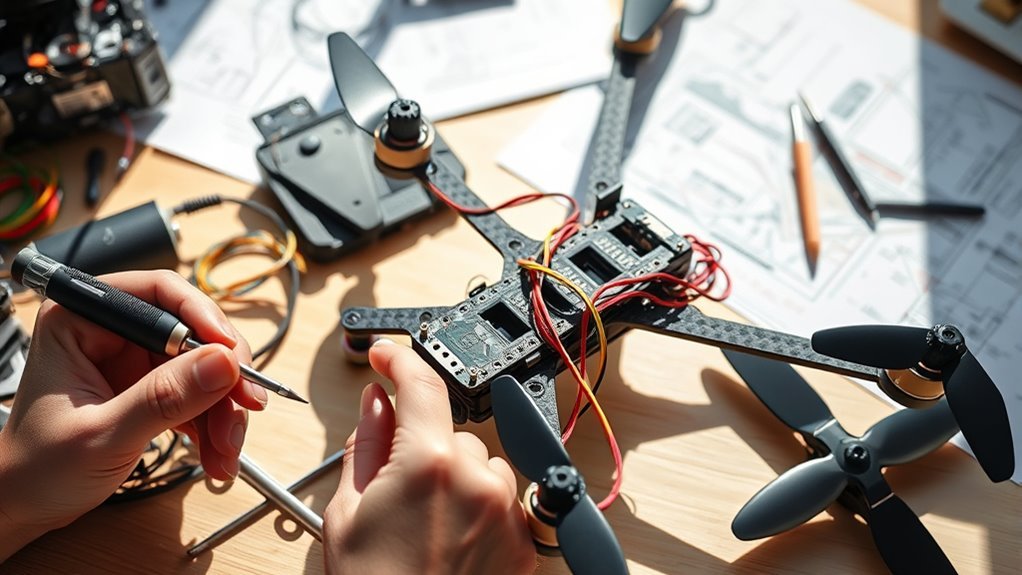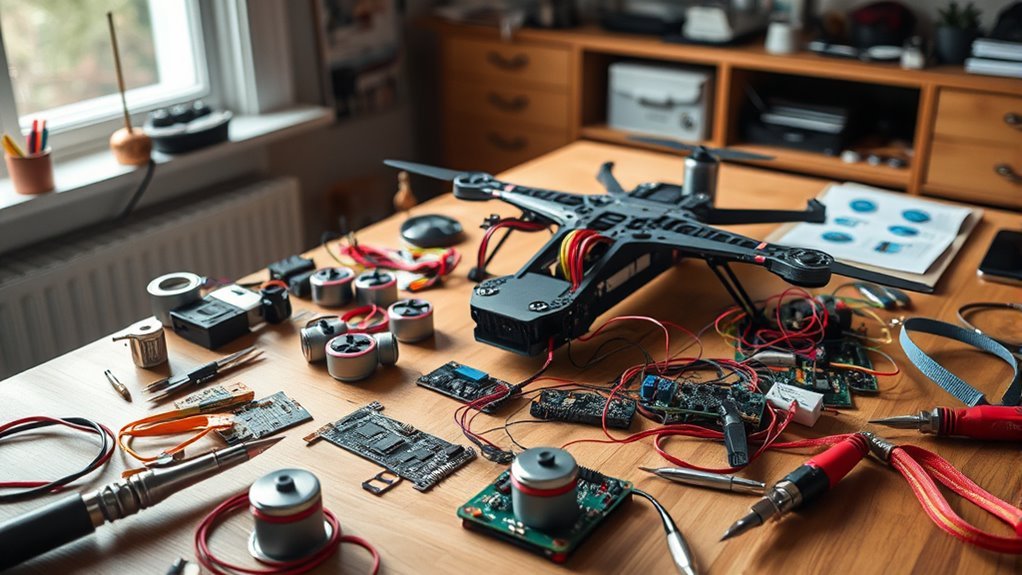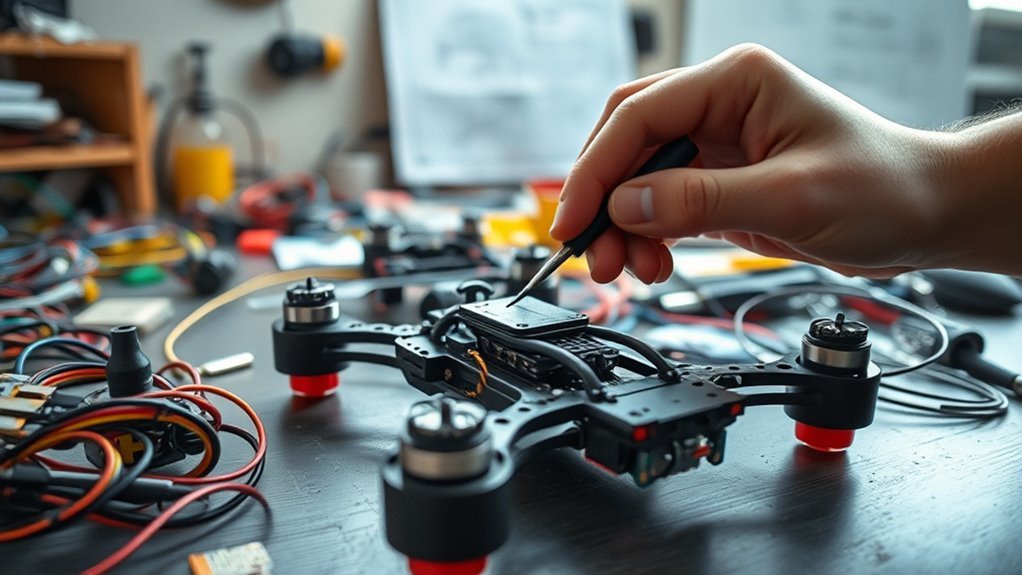To make a drone from scratch, start by understanding the basics of drone components such as the frame, motors, propellers, and electronic systems. Gather essential tools like a soldering iron and multimeter. Choose a frame that suits your design and payload capacity. Select appropriate motors and propellers for efficient flight. Once assembled, install flight control software and calibrate sensors for optimum performance. Safety regulations are vital, so review guidelines to guarantee compliance. There’s much more to explore in this process.
Understanding Drone Basics

When diving into the world of drones, it’s essential to grasp the fundamental components that make up these flying machines. Understanding drone types is your first step; quadcopters, hexacopters, and fixed-wing models serve various purposes, from recreational use to professional aerial photography. Each type has unique flight mechanics influenced by its design and intended function. For instance, quadcopters offer agility and stability, while fixed-wings provide longer flight durations. Recognizing these characteristics helps you choose a drone that aligns with your needs. Additionally, mastering the flight mechanics—such as lift, thrust, drag, and weight—will enhance your piloting skills. With this knowledge, you’ll be better equipped to explore the skies and enjoy the freedom that drone flying provides. Many drones, like the XG Neith, incorporate advanced camera capabilities that enable stunning aerial photography in various lighting conditions. Furthermore, understanding sensor technology is crucial for optimizing image quality and capturing dynamic range in your aerial shots.
Essential Components of a Drone

To effectively build and operate a drone, it is vital to understand the key components that contribute to its functionality. You’ll encounter various drone types, each requiring specific parts. The frame provides structure, while motors and propellers generate lift. The electronic speed controllers (ESCs) regulate motor speed, and the flight controller processes data from sensors to stabilize flight. Power is supplied by a battery, and for communication, a radio transmitter and receiver are significant. Depending on your intended drone applications—be it aerial photography or racing—these components may vary. Familiarizing yourself with these fundamental elements not only enhances your understanding but empowers you to customize your drone for peak performance and versatility. Additionally, understanding swarm technology can greatly improve coordination when using multiple drones for complex displays. For instance, selecting a flight time that suits your needs, like the JJRC H78G’s 15 minutes or the EXO Blackhawk 3’s 35 minutes, can significantly enhance your flying experience.
Tools You’ll Need

While building your drone, having the right tools at your disposal is essential for a successful assembly and calibration process. Start with a soldering iron for connecting electronic components, along with heat shrink tubing for insulation. A multimeter will help you verify connections and troubleshoot issues. You’ll also need a set of precision screwdrivers for securing drone accessories, like motors and propellers. Don’t forget pliers for wire management and a reliable power supply to test your systems. As you work, follow maintenance tips to guarantee longevity; regularly check connections and firmware updates. Additionally, consider investing in a drone with high-quality camera performance to enhance your aerial photography experiences. A drone with advanced obstacle avoidance features can significantly improve your flying experience and safety.
Choosing the Right Frame
Selecting the right frame for your drone is essential, as it directly impacts performance, durability, and weight distribution. You’ll encounter various frame materials, such as carbon fiber, plastic, and aluminum, each offering different benefits. Carbon fiber is lightweight and stiff, ideal for agile maneuvers, while plastic is cost-effective and can absorb impacts, making it suitable for beginners.
When examining frame designs, consider configurations like quadcopters or hexacopters; each shape affects stability and flight characteristics. A well-structured frame guarantees your components fit securely and minimizes vibrations. Think about your intended use—racing, aerial photography, or recreational flying—as this will guide your choice. Prioritize compatibility and ease of assembly to maximize your drone’s potential and your freedom in the skies. Additionally, understanding payload capacity can help in selecting a frame that supports your drone’s intended load and use case. Choosing a frame with durable materials can significantly improve the longevity and resilience of your drone in various flying conditions.
Selecting Motors and Propellers
Motors and propellers are essential components that determine your drone’s flight efficiency and performance. When selecting motors, consider motor types like brushed and brushless; the latter typically offers better power-to-weight ratios and efficiency. Brushless motors are ideal for high-performance drones, while brushed motors are suitable for beginners and smaller builds.
Next, focus on propeller sizes, which directly impact thrust and maneuverability. Larger propellers generate more lift but require more power, while smaller propellers are more efficient at higher speeds. Match the propeller size with the motor’s specifications to achieve peak performance. Balance your choices based on your drone’s intended use—whether for racing, photography, or recreational flying—to guarantee that you release the full potential of your DIY drone. Understanding battery longevity helps optimize your choices for maximum aerial endurance.
Understanding Flight Controllers
A flight controller is the brain of your drone, orchestrating its movements and guaranteeing stability during flight. Understanding flight controller types and features is vital for ideal performance. Here are key aspects to reflect on:
- Types of Flight Controllers: Choose between multi-rotor, fixed-wing, or hybrid systems based on your needs.
- Sensor Integration: Look for controllers with IMUs, barometers, and GPS for enhanced stability and navigation.
- Firmware Flexibility: Opt for controllers that support customizable firmware like Betaflight or ArduPilot, allowing you to tweak settings.
- Communication Protocols: Verify compatibility with your remote control system through protocols like PWM or SBUS.
Selecting the right flight controller empowers you to release your drone’s full potential, giving you the freedom to explore the skies.
Wiring and Assembly
Once you’ve chosen your components, wiring and assembly become essential steps in bringing your drone to life. Start by organizing your workspace; a clean area helps reduce errors. Use proper wiring techniques, such as soldering for secure connections and heat-shrinking to prevent shorts. Verify polarity is correct—miswiring can damage components.
For assembly tips, follow the manufacturer’s guidelines for mounting the flight controller, motors, and ESCs, making sure they’re firmly in place. Keep wires tidy and use zip ties or cable management clips to avoid tangling. Double-check all connections before powering on your drone; this can save you from costly mistakes. With careful wiring and assembly, you’ll be well on your way to enjoying the freedom of flight.
Installing Software and Calibrating
Now that your drone is assembled, it’s vital to install the appropriate flight control software tailored to your setup. You’ll need to configure sensor parameters precisely to guarantee peak performance. Finally, testing and fine-tuning are essential to achieve stability and responsiveness in flight.
Choosing Flight Control Software
Selecting the right flight control software is essential for optimizing your drone’s performance and ensuring stable flight. You’ll need to choose between open source options and proprietary software, each offering unique benefits. Here’s what to take into account:
- Customization: Open source platforms allow for extensive modifications to meet your specific needs.
- Community Support: Many open source options have active communities for troubleshooting and enhancements.
- Cost: Proprietary software often comes with licensing fees, while open source is typically free.
- User Interface: Evaluate the ease of use; some proprietary software offers more intuitive interfaces.
After selecting your software, install it and calibrate your drone’s components for precise control, ensuring that your flying experience is both enjoyable and efficient.
Configuring Sensor Parameters
As you explore configuring sensor parameters, it is crucial to guarantee that the software you installed effectively communicates with your drone’s hardware. Begin by performing sensor calibration to verify accurate readings. This step involves aligning the sensors with their expected outputs. Once calibrated, engage in parameter tuning, adjusting settings to optimize performance based on your specific use case.
| Sensor Type | Calibration Method |
|---|---|
| Gyroscope | Rotate in all axes |
| Accelerometer | Level and tilt adjustments |
| Magnetometer | Spin 360 degrees |
| Barometer | Altitude reference setting |
| GPS | Wait for satellite lock |
Testing and Fine-Tuning
With the sensor parameters properly configured, the next step involves rigorous testing and fine-tuning of your drone’s software. You’ll want to guarantee peak performance through a series of procedures. Focus on the following aspects:
- Conduct flight stability analysis to assess responsiveness.
- Implement performance enhancement techniques for smoother flights.
- Adjust PID settings for better control.
- Test various flight modes to evaluate functionality.
Safety Tips and Regulations
Before you take to the skies, it’s essential to understand the legal requirements governing drone operation in your area. Familiarizing yourself with flight safety practices and equipment safety standards can greatly reduce risks associated with flying your drone. Adhering to these guidelines guarantees not only your safety but also the safety of others around you. Additionally, be aware that certain drones, such as commercial drones used for business purposes, require mandatory registration to ensure compliance with regulatory standards. Furthermore, understanding airspace limits is crucial to avoiding potential legal repercussions while flying your drone.
Legal Requirements Overview
Understanding the legal requirements for flying a drone is crucial for any operator, especially given that regulations can vary markedly by location. To guarantee a smooth flying experience, keep the following points in mind:
- Drone registration: Most jurisdictions require you to register your drone with the relevant authorities.
- Airspace regulations: Familiarize yourself with controlled and restricted airspaces where flying may be prohibited or require special permission.
- Weight limits: Check the weight limits for your drone to avoid fines or penalties.
- Privacy laws: Be aware of local privacy laws to respect the rights of individuals while flying.
Flight Safety Practices
Although flying a drone can be an exhilarating experience, adhering to flight safety practices is essential to minimize risks and guarantee compliance with regulations. Start every flight with a thorough pre flight checklist, ensuring your drone’s components are functional and secure. Check battery levels, propeller integrity, and GPS connectivity to prevent unexpected failures. Familiarize yourself with emergency procedures; knowing what to do in case of a malfunction can save your drone and mitigate risks to people and property. Always maintain a visual line of sight and avoid restricted airspace. By following these safety protocols, you not only protect yourself but also contribute to the broader community of drone enthusiasts, allowing everyone to enjoy the freedom of flight responsibly.
Equipment Safety Standards
Following established flight safety practices naturally leads to the importance of adhering to equipment safety standards. To guarantee your drone meets the necessary regulations, focus on equipment compliance and obtaining the right safety certifications. Here are key points to contemplate:
- Verify materials used for frame and components meet safety standards.
- Ensure batteries are certified and properly rated for your drone’s specifications.
- Regularly inspect electronics for wear or damage that could lead to failure.
- Familiarize yourself with local regulations governing drone operation to avoid legal issues.
Testing Your Drone for the First Time
Before you take to the skies, it’s essential to conduct a series of tests to confirm your drone operates safely and effectively. Start by following a pre-flight checklist to verify all components are functioning correctly. Once you’ve verified everything, perform your initial flight test in an open area away from obstacles. This will allow you to assess stability, control, and responsiveness. The DJI Mini 2 SE provides excellent stability during flight tests, making it a great reference for performance expectations.
| Checklist Item | Status | Notes |
|---|---|---|
| Battery Charged | Yes/No | |
| Propellers Secure | Yes/No | |
| Firmware Updated | Yes/No |
After completing your initial flight test, review the data collected and make necessary adjustments. This meticulous approach will enhance your flying experience and confirm your drone’s longevity. Additionally, consider the impact of aerodynamic design on your drone’s speed performance during these tests.
Frequently Asked Questions
How Much Does It Cost to Build a Drone From Scratch?
Building a drone from scratch can cost anywhere from $200 to $1,500, depending on drone parts. To stay within budget, consider sourcing components second-hand or opting for beginner kits that provide essential elements without breaking the bank.
Can I Upgrade My Drone Components Later?
Yes, you can upgrade your drone components later. Just guarantee component compatibility when selecting new parts. Explore various upgrade options to enhance performance, allowing you to customize your drone according to your specific needs and preferences.
What Are Common Mistakes to Avoid When Building a Drone?
When building a drone, avoid common mistakes like poor wire connections, which can lead to failures, and improper weight distribution, causing instability. Prioritize these aspects for successful flight performance and enhanced freedom in aerial navigation.
How Long Does It Take to Build a Drone?
Building a drone typically takes anywhere from a few hours to several days, depending on your experience and the complexity of the design. Following drone assembly tips can streamline your build timeline considerably, enhancing efficiency.
Where Can I Find Drone Building Communities Online?
Did you know over 60% of drone enthusiasts join online communities? You’ll find valuable drone forums and online workshops on platforms like Reddit and Facebook, where you can connect, share knowledge, and enhance your building skills.

